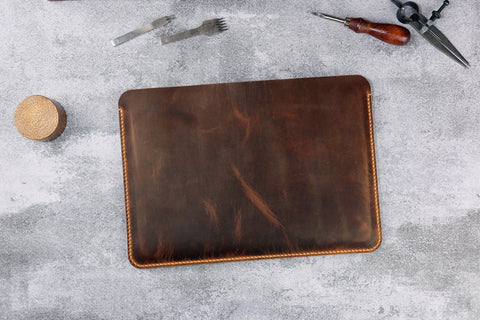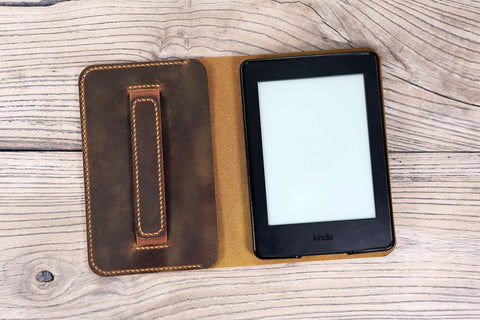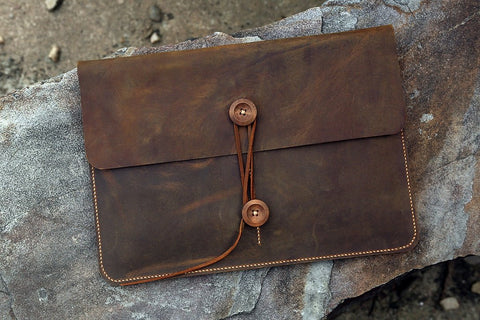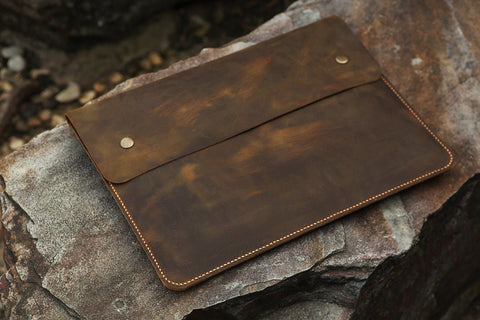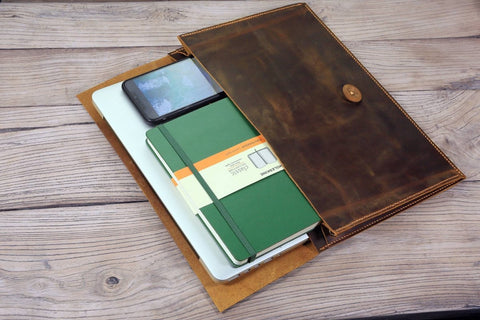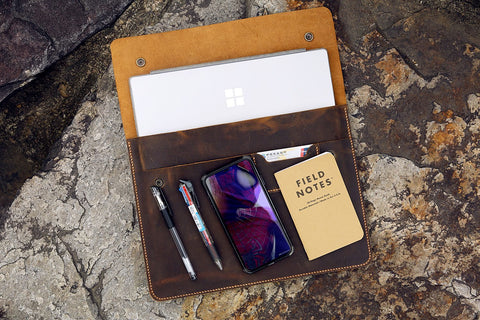Three forms of leather craftsmanship
In ancient societies, alongside advancements like farming and pottery making, artisan leather designs found themselves momentarily overshadowed. Yet, as centuries unfolded, the enduring allure of leather artistry re-emerged, flourishing through innovations in tanning, printing, dyeing, and notably, carving. This renaissance of leather craftsmanship heralded a new era of prosperity in the use of leather, transcending mere functionality to become a canvas for human expression and cultural identity.
The 20th century marked a pivotal moment for leather crafts, witnessing a diversification in artistic and material development driven by an evolving quest for spiritual and cultural enrichment. Leather art can be broadly categorized into:
1、Practical Leather Creations
Traditional and modern leather products represent the spectrum of practical leather creations. Traditional items often feature intricate leather carvings, including esteemed motifs like Tang Grass patterns and Sheridan style, emblematic of handcrafted leather folk art found in regions rich in leatherworking heritage, such as northern China. Modern leather goods prioritize simplicity and functionality, catering to everyday needs.
Tang Grass Patterns
Origin and History: Tang grass patterns, also known as "Tang Dynasty patterns" or "Chinese traditional cloud patterns," originate from China, particularly flourishing during the Tang Dynasty (618–907 AD). This style is characterized by its flowing, interconnected designs that resemble the natural forms of plants, clouds, and sometimes animals.
Design Characteristics: The patterns are often symmetrical and feature graceful curves, creating a sense of movement and harmony. They are inspired by the natural world, with motifs including flowers, vines, leaves, and clouds. These patterns are not only used in leather but also in textiles, metalwork, and ceramics.
Cultural Significance: In Chinese culture, Tang grass patterns symbolize good fortune, prosperity, and the interconnectedness of life. They reflect the high aesthetic standards of the Tang Dynasty, known for its golden age of art and culture.
Leather Applications: On leather, Tang grass patterns are usually embossed or carved, requiring skilled craftsmanship. The patterns can adorn a variety of leather goods, such as wallets, belts, handbags, and traditional Chinese clothing accessories. The intricate designs demand precision and are a testament to the artisan's expertise.

Tang Grass Pattern from China
Sheridan Style
Origin and History: Sheridan style carving originated in the United States, particularly in Sheridan, Wyoming, hence its name. It became popular in the mid-20th century and is a distinctive style of Western leather carving that has influenced leatherwork worldwide.
Design Characteristics: Sheridan style is known for its bold, intricate patterns featuring flowers, leaves, and scrolls. The designs are deeply carved and often highlighted with tooling and stamping to create a three-dimensional effect. The style emphasizes high contrast between the carved and uncarved areas, making the patterns stand out dramatically.
Cultural Significance: This style reflects the rugged beauty and spirit of the American West. It's synonymous with cowboy culture, embodying themes of freedom, nature, and the outdoors. Sheridan style has become iconic in Western tack and gear, including saddles, holsters, and belts.
Leather Applications: Sheridan style carving is commonly found on items that demand durability and longevity, such as horse tack, cowboy boots, belts, and wallets. The deep carving and robust tooling not only serve aesthetic purposes but also enhance the texture and strength of the leather goods.
Both Tang grass patterns and Sheridan style carvings require a high level of skill and patience, making them prized among collectors and enthusiasts of traditional leatherwork. These styles continue to be celebrated for their beauty and craftsmanship, bridging past and present in the world of leather art.

Sheridan Style Leather Work
Another type is the handmade traditional folk art preserved in leather producing areas such as northern China.
Modern leather products are mainly made up of daily necessities, with simple shapes and a greater emphasis on practicality.

Modern leather products "Original Heart" ( Cai Honghao China)
2、Decorative Leather Handicrafts
With a penchant for flat decoration, this category spans decorative leather paintings, leather relief art, and pioneering forms that marry technology with craftsmanship. Three-dimensional leather sculptures and reliefs mimic the natural world, showcasing leather's versatility as a medium for both traditional and innovative leather art.
Decorative Paintings on Leather
Overview: Decorative paintings on leather transform this traditional material into a vibrant canvas, displaying a wide range of subjects from abstract designs to detailed landscapes and portraits. It serve as vibrant canvases, from abstract compositions to lifelike portraits, celebrating leather's texture and natural aging process.
Techniques: Artists may apply dyes, acrylics, or specialized leather paints directly onto the surface, utilizing the unique texture and color variations of the leather to enhance the artwork. Techniques can vary from airbrushing for subtle gradients to hand-painting for intricate details.
Significance: Leather decorative paintings offer a depth and warmth not found in traditional canvas art. The natural aging process of the leather adds to the character of the piece, making each artwork not just a visual experience but a journey through time.

Decorative paintings on leather (China)
Relief Forms in Leather Art
Overview: Relief forms in leather art create a dynamic, tactile experience, where the designs stand out from the background, offering a 3D effect that invites touch.It offer a tactile and visual depth, prized for their elegance in wall art and high-end design.
Techniques: This is achieved by molding, carving, or embossing the leather when it's damp, allowing for intricate patterns or scenes to be raised above the surface. As the leather dries, it retains the form, creating a lasting impression.
Significance: Relief leather work is prized for its depth and texture. It can be used in wall art, luxury book covers, and high-end product design, offering an elegance and sophistication that enhances the aesthetic appeal of any item or space.


Relif forms in leather art(Ye fayuan China)
Integrating Technology in Leather Art
Overview: The integration of technology with leather art represents the frontier of contemporary leather craftsmanship, blending the tactile beauty of leather with the endless possibilities of modern tech.
Techniques: Techniques include laser engraving and cutting, which allow for precision and complexity beyond traditional hand tools. Additionally, artists might incorporate electronic elements, such as LED lighting or interactive sensors, into their creations, making the art responsive or interactive.
Significance: Tech-integrated leather art breaks the boundaries between traditional craft and modern innovation. It opens up new avenues for customizations and functionalities, from personalized laser-engraved designs to wearable tech fashion and smart leather goods that combine utility with style.
Leather Sculptures
Overview: Leather sculptures are intricate three-dimensional artworks crafted entirely from leather. These can range from lifelike animal figures to abstract forms, showcasing the versatility of leather as a sculptural medium.
Techniques: Artists typically mold and shape wet leather, taking advantage of its pliability. As the leather dries, it retains its form, allowing for the creation of detailed sculptures. Additional techniques like carving, stitching, and dyeing can be employed to add texture, color, and realism.
Significance: Leather sculptures can serve as standalone art pieces or functional objects, such as vases or bowls. They are often admired for their craftsmanship and the way they uniquely age over time, developing a patina that adds to their beauty.


Leather art mural works(Wang miao China)
Leather Figurines and Puppets
Overview: These are small, detailed figures or puppets made from leather, often representing animals, mythical creatures, or human characters. They can be purely decorative or used in puppetry and storytelling.
Techniques: Making leather figurines involves cutting, shaping, and stitching leather to form three-dimensional shapes. Artisans may use wires or other materials to create a skeleton structure for the figure, then layer and mold leather around it to build up the form.
Significance: Leather figurines and puppets are celebrated for their detail and expressiveness. They often carry cultural significance, representing folklore, traditional stories, or symbolic motifs. As collectibles or toys, they showcase the playful and imaginative potential of leatherwork.
3.Innovative Leather Art Forms
This realm explores uncharted territories of creation, including leather murals, sculptures, and installation art. It reflects how traditional leather brands are adapting to contemporary trends, blending age-old skills with new technologies to forge fresh expressions of leather art.
Breaking through the above two fixed modes, there is a more free and flexible creative space, such as murals, sculptures, installation art, etc. And some traditional leather brands are also constantly transforming their traditional skills with the development of the times, adopting new technological means, and exploring new forms of expression.
The evolution of leather craftsmanship demonstrates the material's remarkable adaptability across practical, decorative, and avant-garde applications. Today, leather's role extends beyond utility, playing a pivotal part in the worlds of daily use, decor, and fine art, thanks to the comprehensive development of leather crafting techniques.

Leather crystal artwork (An outstanding graduate China)
Conclusion:The modern expression of these three types of leather art also proves that the current level of leather craftsmanship development is sufficient to develop the plasticity of leather materials. In the fields of daily use, decoration, and art, the role of leather materials is gradually being reflected. The current era has complete conditions, and the use of leather materials should gradually focus on areas beyond practical applications.
1 comment
-
Posted on by Roberto GutierrezIt is great idea.I wood like to learn how to work we this técnico ,leather is my hobby



